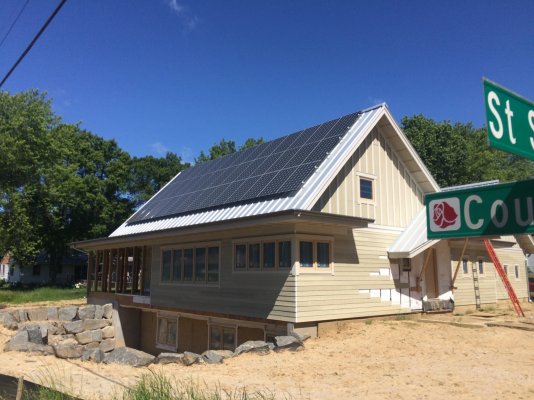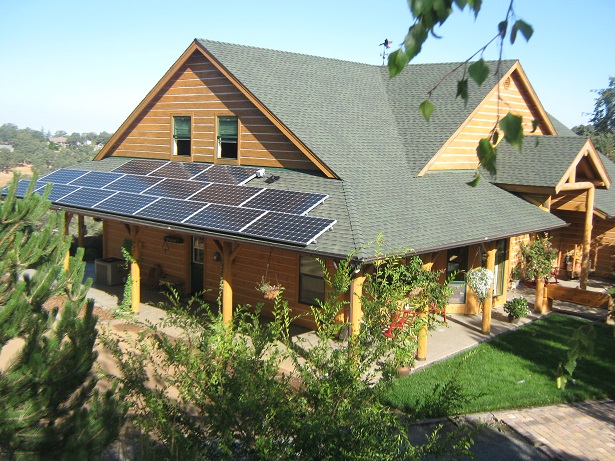Fascinating chart. Can you get the production vs consumption numbers in a weekly or monthly format - I only saw daily?
Yes, you are viewing the 'live' chart. Click on the daily, weekly, monthly, yearly buttons for further out charts. Also, click on the day, a calendar pops up and you can look at any day of the year.
So I see you do produce more solar power net than you use (at least in June).
Yes, for June, but look at January. Almost no solar production. That is why 'true up' with the electric company is once a year. I make more power now, it's banked. I use more power in the winter, it's withdrawn.
Looks like you are a fairly light kWh consumer ( ~ 500 kWh/month)? Why would you want to build out more, when you already produce more than you use?
Weather is cool right now. Here's a link to June 4th where I ran my AC and the outdoor temps got above 100;
PVOutput
What's the payback on your $16,400 investment? I don't know your kWh rates, but assuming ~ 30 cents in CA, and 500 kWh/month, that's (ignoring the 4 cents for excess for now) ...
I figure I will recover my investment in 8 years unless electric rates increase over the next 8 years, then I'll recover my capital sooner. Right now, summer rates are 15 cents a Kwh from 9pm at night until 10am the next day. From 10am to 1pm it's 23 cents, from 1pm to 7pm it's 34 cents, 7pm to 9pm back to 23 cents and then it starts all over again. Weekends and holidays are a little different.
This is why it pays me to generate and bank during peak rate times and run my AC on the shoulder or off peak rate times. I can use twice the amount of electricity during off peak if I bank it during peak.
500 ⋅ 0.3 ⋅ 12 = 1800 $1800 generated annually, so payback of around 9 years, not counting opportunity cost of the investment. But if we count opp cost at a conservative 3.5% WR, that pulls $575 out of the savings, so around 13 years?
Only if electric rates NEVER raise during that time. Based on my last 10 years living here, electric rates have risen an average of 7% a year. Do the math now, based on the figures I gave you for time-of-use rates AND a 7% rate increase annually. I'll have my capital investment back relatively shortly.
Also, the solar equipment has a 25 year warranty and the labor is 15 years. No risk for me.
That's why it's hard for the numbers to work in areas like IL, with lower kWh rates - payback takes near the life of the panels, which might outlive me!
I have almost 300 days of sunshine a year here in California where I live. Annual rain fall is 36 inches over 66 days average.
California has a bill in the legislature that at least 50% of all energy must be from renewable resources by some future date to be determined. That is a lot of capital they'll have to expend and soon too. By 2020, in less than 4 years, California must be at least 33% renewable. That mandate is law.
Here's a news article about it;
California renewable energy mandate
Consider this;
If you had the opportunity to pay up front for electricity for a guaranteed 25 years, what would it be the dollar cost that would make it a decent long term investment. A lot of people get hung up on the 8 to 13 years of recovery of their capital investment plus earnings loss, but after that, it's all basically free electricity. I have now fixed my cost for electricity for the rest of my life, long as I remain in this house. The mortgage is paid, so no cost there. I have a well I put in a while back, (California drought? What's that?) it has it's own little battery/solar power source since that was cheaper than running power all the way to the pump house. It's a 12 volt system. If I can get off propane, or at least reduce it to a couple hundred dollars a year, I'll pretty much have no real monthly living expenses other than food and gasoline for my (paid off) cars. There's still property taxes (prop 13 has limited that to 2% increase max a year based on the market value of the house.) and insurance costs. My total monthly expenses are under $2,000 a month. My income is around $6,000 a month in retirement with a pension and 2% draw from my investments. I will start getting around $2500 a month (me and DW) in 2 years for Social Security. At that time, I won't need any draws from my investments.
My feeling is, I am not risk tolerant and now I don't have to be. Locking in electric rates for the next 25 years is one piece of the pie for achieving that goal, like the well was.





